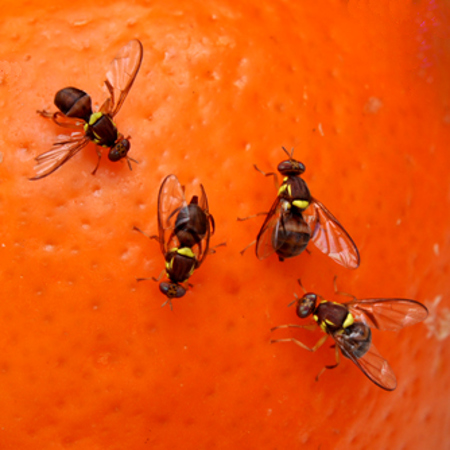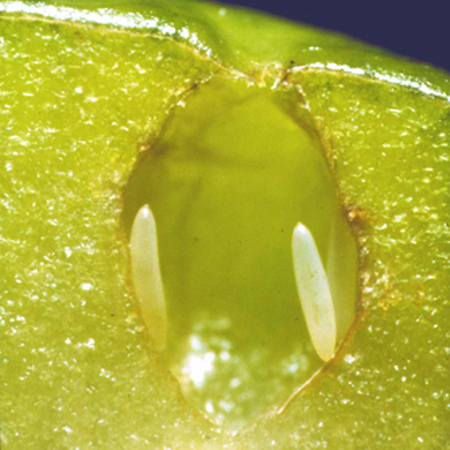Fruit Fly
BackThere isn’t anything worse than biting into a piece of fruit that has been infested with fruit fly and seeing those little wriggling maggots. Yuk! Then that awful thought “Did I just eat one?” Double YUK!
Fruit flies are a serious pest in Australia with two main types to worry about: the Queensland Fruit Fly (Bactrocera tryoni) and the Mediterranean Fruit Fly (Ceratitis capitata). Despite its name the QLD fruit fly has spread and is now found in NSW, VIC, ACT and NT as well as QLD. It is 5-7mm long. The Mediterranean fruit fly (Medfly) is only found in WA and is 3-5mm long. Currently Tasmania and South Australia are officially fruit fly free. SA does experience fruit fly outbreaks but moves quickly to contain them.
Understanding their lifecycle is key to controlling fruit fly. Female flies emerge from the soil and immediately feed on protein in order to become sexually mature. They obtain protein from animal droppings, bacteria on leaves and juices in fruits. Once mated the female inserts up to twelve eggs just under the skin of fruits. The eggs hatch and the maggots feed on fruit tissue which usually results in rot developing and the fruit dropping to the ground. The maggots wriggle out and burrow into the soil where they pupate, emerging later as adults. This cycle is repeated multiple times in a season with fly numbers much greater by the second half of summer. As winter approaches the pupae will remain in the soil to avoid the cold and emerge in spring when it warms up again.
Females need only mate once or twice in their lifetime and will lay several hundred eggs. Both males and females feed on sugars for ongoing energy and live for many weeks. Sugars are obtains from flower nectar and also the sweet secretions (honeydew) of sap sucking insects like aphids and whitefly.
When fruit has been stung it usually looks like a pin prick and will sometimes ooze sap. On tomatoes the pin prick often stays green while the rest of the fruit colours up. With other fruits, rotting or cracking can occur at the pin prick site.
Fruit fly populations are increasing across Australia as our winters become milder, summers longer and people neglect their fruiting plants. As such flies are active earlier each year and will sting rock hard green fruit. Monitoring male populations and spraying early will prevent their numbers escalating later in the season.
NOTE: Tiny flies (1-2mm) which buzz around fruit bowls and compost heaps are not fruit flies. These are vinegar or fermentation flies.
Plants Attacked
Fruit fly can sting just about any type of fruit when fly population levels are high but they do have some favourites including: stone fruits, loquats, guavas, tomatoes, feijoas and citrus. Other plants they commonly attack are apples, eggplants, capsicums, avocadoes, quinces, bananas, figs, mangoes, olives, passionfruit, pears and walnuts. The Queensland fruit fly will also sting the fruits of lilly pillies and other natives.
Organic Control Methods for Fruit Fly
It is essential that you act early to protect fruit and prevent fly populations building.
- Hang eco-lure fruit fly traps late winter to act as monitoring stations. These will attract and kill male QLD fruit flies and alert you to when flies are active in your area. Unfortunately eco-lure does not work on Medfly in WA.
- Apply eco-naturalure when males first appear in the eco-lure trap or at petal drop. Flies can sting fruit that is small and immature (even the size of a marble) so early application is recommended for maximum protection.
- Also apply eco-naturalure around chook pens and compost heaps as fruit flies will be attracted to these areas as they look for protein.
- Clean up any fallen fruit immediately. Place in sealed plastic bags and leave in the sun for a week to cook any larvae. Only then can they be added to the compost heap.
- Fruit flies can travel several kilometres so encourage neighbours to do the same in order to create a larger protection zone.
Some gardeners also plant early cropping varieties so they can harvest before Christmas when fruit fly numbers are lower. Others use exclusion bags on particularly susceptible fruits like peaches.





